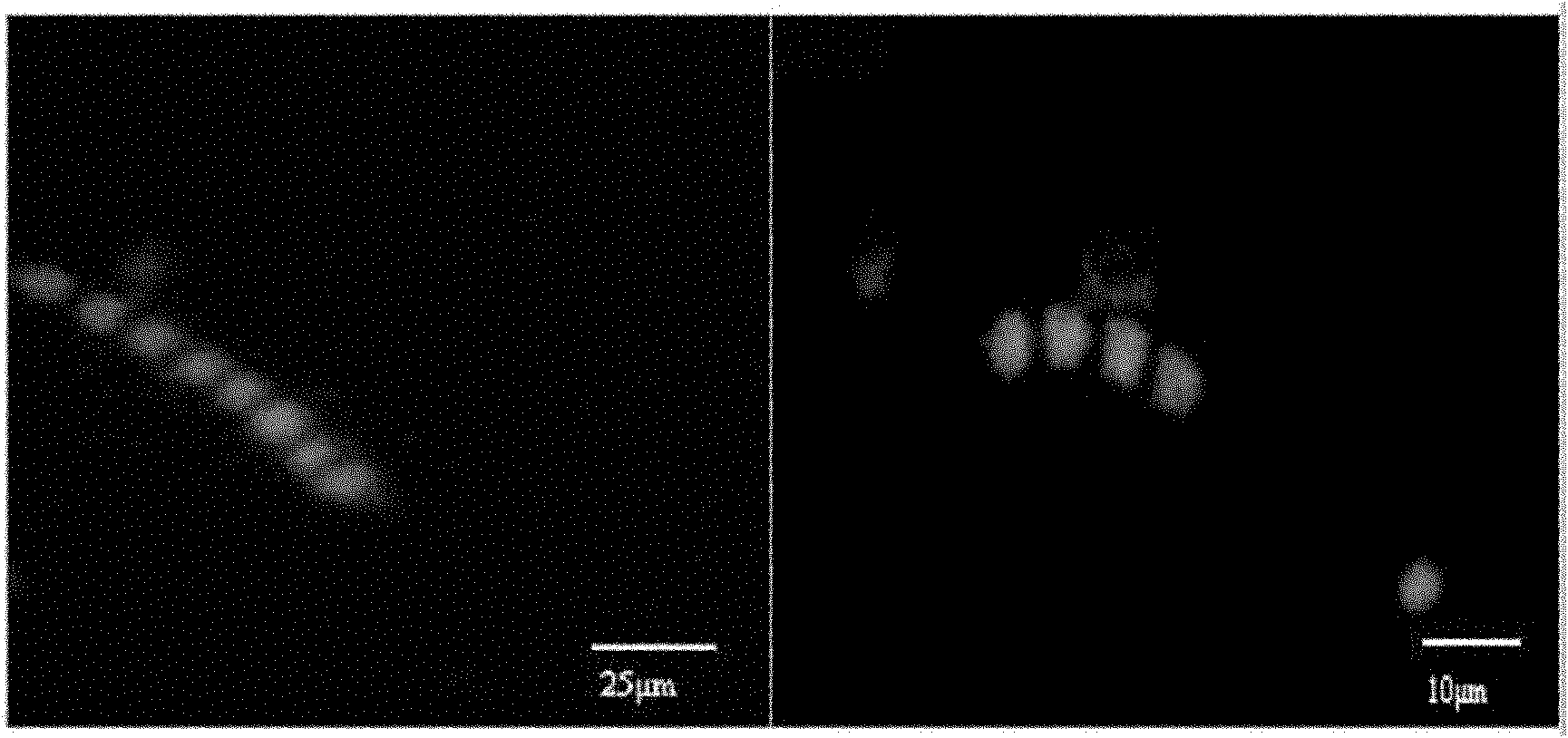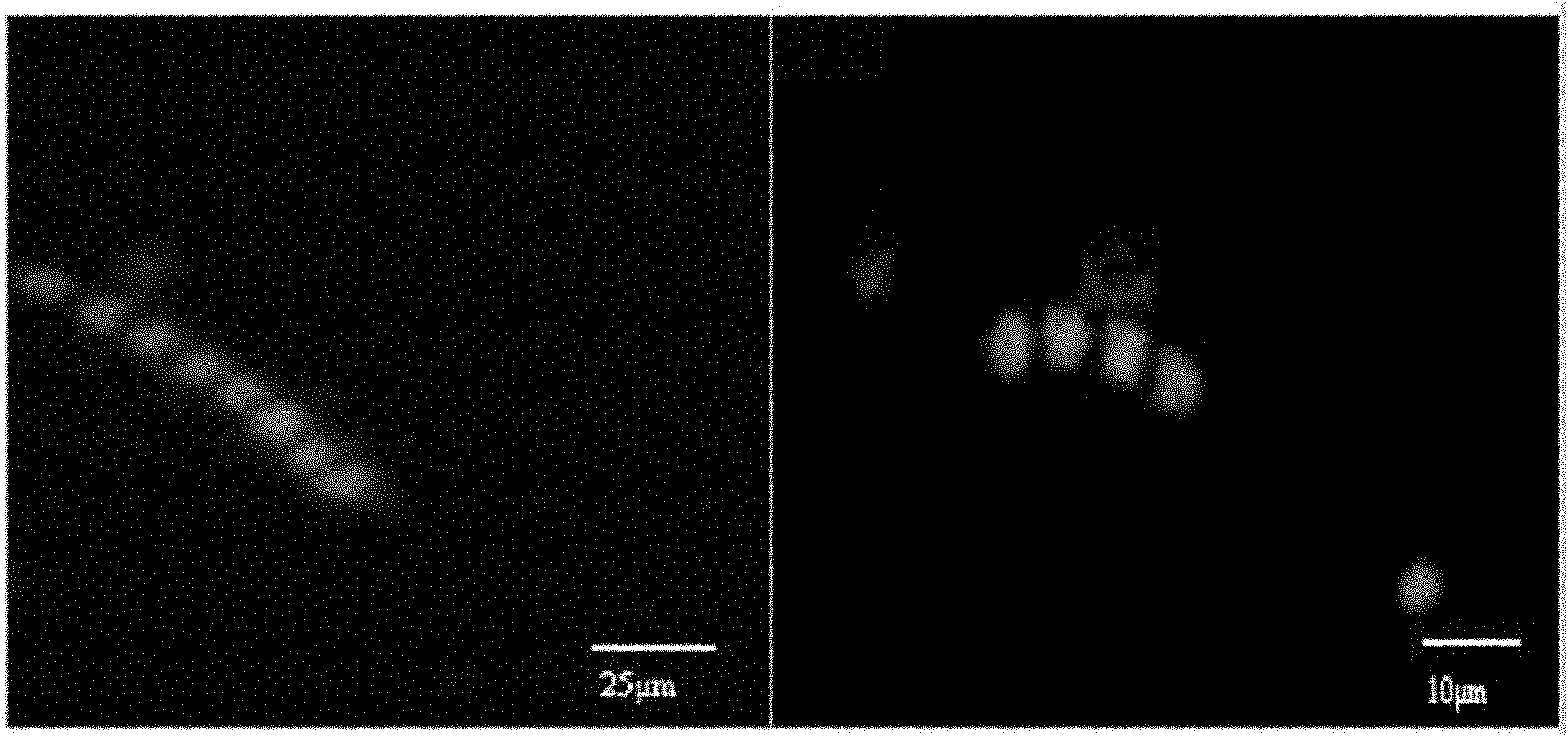Detection method of symbiotic bacteria in sponge cell based on quantum dot fluorescence in-situ hybridization
A technology of fluorescence in situ hybridization and symbiotic bacteria, applied in biochemical equipment and methods, fluorescence/phosphorescence, microbial measurement/inspection, etc., can solve the problems of difficult antigen-antibody reactions, low antigenicity, and complex components. Achieve the effect of avoiding the interference of autofluorescence
- Summary
- Abstract
- Description
- Claims
- Application Information
AI Technical Summary
Problems solved by technology
Method used
Image
Examples
Embodiment 1
[0029] The specific implementation steps of this embodiment are as follows:
[0030] 1. Isolation of sponge cells:
[0031] (1) The following operations are performed under sterile conditions. Spongy tissue (1-2g) was thawed at 4°C and cut into pieces no larger than 0.5cm 3 of small pieces. Add 15-20 times the volume of artificial seawater (1.1g CaCl 2 , 10.2 g MgCl 2 ·6H 2 O, 31.6g NaCl, 0.75g KCl, 1.0g NaCl 2 SO 4 , 2.4g Tris / HCl, 0.02g NaHCO 3 , 1L deionized water, pH 7.6) in an Erlenmeyer flask, 110rpm, 20°C gentle shaking for 40min-60min.
[0032] (2) Gently rubbing the sponge fragments washed in the previous step on a 200-mesh stainless steel cell sieve for mechanical dissociation, allowing the sponge fragments to become a paste, while using 20-25 times the volume of calcium-magnesium-free artificial seawater ( 31.6g NaCl, 0.75g KCl, 1.0gNa 2 SO 4 , 2.4g Tris / HCl, 0.02g NaHCO 3 , 7.2g EDTA, 1L deionized water, pH 7.6) wash, transfer to Erlenmeyer flask at 110...
Embodiment 2
[0040] The specific implementation steps of this embodiment are as follows:
[0041] 1. Isolation of sponge cells:
[0042] (1) The following operations are performed under sterile conditions. Spongy tissue (1-2g) was thawed at 4°C and cut into pieces no larger than 0.5cm 3 of small pieces. Add 15-20 times the volume of artificial seawater (1.1g CaCl 2 , 10.2 g MgCl 2 ·6H 2 O, 31.6g NaCl, 0.75g KCl, 1.0g NaCl 2 SO 4 , 2.4g Tris / HCl, 0.02g NaHCO 3 , 1L deionized water, pH 7.6) in an Erlenmeyer flask, 110rpm, 20°C gentle shaking for 40min-60min.
[0043] (2) Gently rubbing the sponge fragments washed in the previous step on a 200-mesh stainless steel cell sieve for mechanical dissociation, allowing the sponge fragments to become a paste, while using 20-25 times the volume of calcium-magnesium-free artificial seawater ( 31.6g NaCl, 0.75g KCl, 1.0gNa 2 SO 4 , 2.4g Tris / HCl, 0.02g NaHCO 3 , 7.2g EDTA, 1L deionized water, pH 7.6) wash, transfer to Erlenmeyer flask at 110...
Embodiment 3
[0051] The specific implementation steps of this embodiment are as follows:
[0052] 1. Isolation of sponge cells:
[0053] (1) The following operations are performed under sterile conditions. Spongy tissue (1-2g) was thawed at 4°C and cut into pieces no larger than 0.5cm 3 of small pieces. Add 15-20 times the volume of artificial seawater (1.1g CaCl 2 , 10.2 g MgCl 2 ·6H 2 O, 31.6g NaCl, 0.75g KCl, 1.0g NaCl 2 SO 4 , 2.4g Tris / HCl, 0.02g NaHCO 3 , 1L deionized water, pH 7.6) in an Erlenmeyer flask, 110rpm, 20°C gentle shaking for 40min-60min.
[0054] (2) Gently rubbing the sponge fragments washed in the previous step on a 200-mesh stainless steel cell sieve for mechanical dissociation, allowing the sponge fragments to become a paste, while using 20-25 times the volume of calcium-magnesium-free artificial seawater ( 31.6g NaCl, 0.75g KCl, 1.0gNa 2 SO 4 , 2.4g Tris / HCl, 0.02g NaHCO 3 , 7.2g EDTA, 1L deionized water, pH 7.6) wash, transfer to Erlenmeyer flask at 110...
PUM
 Login to View More
Login to View More Abstract
Description
Claims
Application Information
 Login to View More
Login to View More - R&D
- Intellectual Property
- Life Sciences
- Materials
- Tech Scout
- Unparalleled Data Quality
- Higher Quality Content
- 60% Fewer Hallucinations
Browse by: Latest US Patents, China's latest patents, Technical Efficacy Thesaurus, Application Domain, Technology Topic, Popular Technical Reports.
© 2025 PatSnap. All rights reserved.Legal|Privacy policy|Modern Slavery Act Transparency Statement|Sitemap|About US| Contact US: help@patsnap.com


